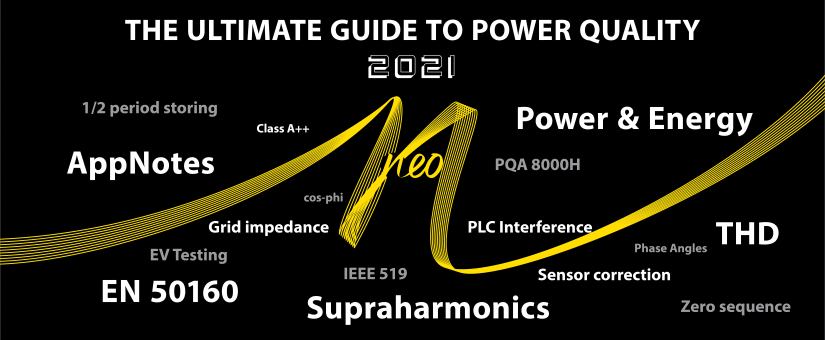
The Ultimate Guide to Power Quality in 2021
- Posted by Neo Messtechnik
- On 17. March 2021
- 0 Comments
From “½ period storing” to “Zero sequence”, here are all the terms, standards and abbreviations you need to understand Power Quality in 2021.
The Modern Power Quality Dictionary
After all, it’s really easy to get lost in all the Power Quality terms, standards and their relations to each other, even for us. Earlier this month in one of our meetings the idea of a Power Quality Dictionary was born. In other words, who stops us to write the ultimate guide to Power Quality for 2021? Long story short, here we are, sharing our first draft with you.
Maybe we needed and wanted to write this for ourselves, because we didn’t find anything similar on the net. Then again, maybe you can profit as well or even propose terms to be added in the future?
So without further ado, here are all the Power Quality terms you need. Some are basic or self-explanatory, others require in-depth knowledge. But all will help you to understand Power Quality as of today.
½ period storing
Comes in very handy when your PQ instrument let’s you choose this option. Recording and Analysing 10-period values makes it impossible to make short-time interruptions visible. In addition,the 10-period value will only show a reduced peak value of disturbances, as it is averaged over a couple of periods. The peak of ½ period values (real value) can be a couple of times higher than the measured 10-period value. For example, we offer our customers to store half-period values of U,I,P,Q,S, phi, symmetrical components, fundamentals, among others.
Active, Apparent and Reactive Power
Shape a beautiful rectangular triangle (click for the famous power triangle).
AC/DC Hall clamps
Easy-to-mount. AC and DC current measurements. Based on the Hall Effect – the measured current through a magnetic core’s aperture equals magnetic flux change leading to induced voltage. Ideal for Grid & Renewables.
AppNotes
Comprehensive theoretical and practical discussions on measurements, applications and successful handling of partner’s or customer’s challenges, similar to white papers. Reach out to us or access our AppNotes by simply navigating to your personal NEO Download Area.
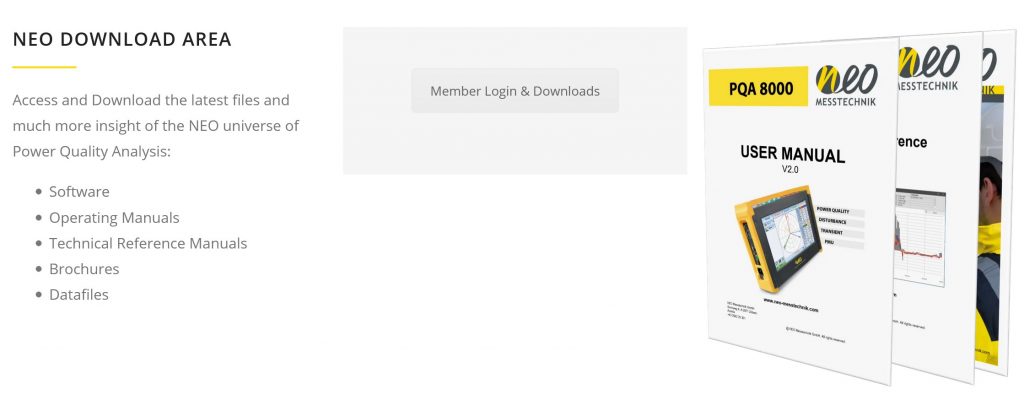
More in-depth information
Often referenced in this article. Easy accessible in your Download Area. Sign up!
Bandwidth, Resolution and Sampling Rate
By choosing the wrong instrument without a high bandwidth, among others, you potentially limit your measurement capabilities from the get-go. Standard PQ Analyser come with the standard problem of being outdated for detecting various problems in today’s power grid. See Supraharmonics or Chapter 1 of Power Quality Explained.
Blackout
Worst-Case Scenario that is prevented through the common effort and co-operation of TSOs and all parties involved in ensuring a safe and reliable power supply. Almost happened at the beginning of 2021 in Europe.
CAT III 1000V / CAT IV 600V
In brief, safety is very important and should be regarded in the design process of PQ instruments. However, you would be surprised how often we see instruments that don’t fulfil the safety category requirements for the respective measurements. Therefore HV- inputs that are labelled as CAT IV ensure users and engineers safety and an instrument design that prevent electrical accidents. As an example, the inputs of the NEO PQA8000 are CAT IV 600V, isolated up to 6kVp while maintaining high precision (0.05%) and high sampling (up to 1MS/s).
Class A
Basically, by choosing a Class A complying instrument, you make the first important step for getting reliable results according to the IEC 61000-4-30. At the same time, let us guide you through all the reasons to aim for even higher Power Quality standards in our Multi-Part Series Chapter 2.
DER
Distributed Energy sources like wind, solar or PV power plants.
Efficiency
Essentially drives the whole industry to work resource-saving and manage both economic and technical bottlenecks throughout the whole electricity sector. Generally puts output into relation to input to a system in per cent [%].
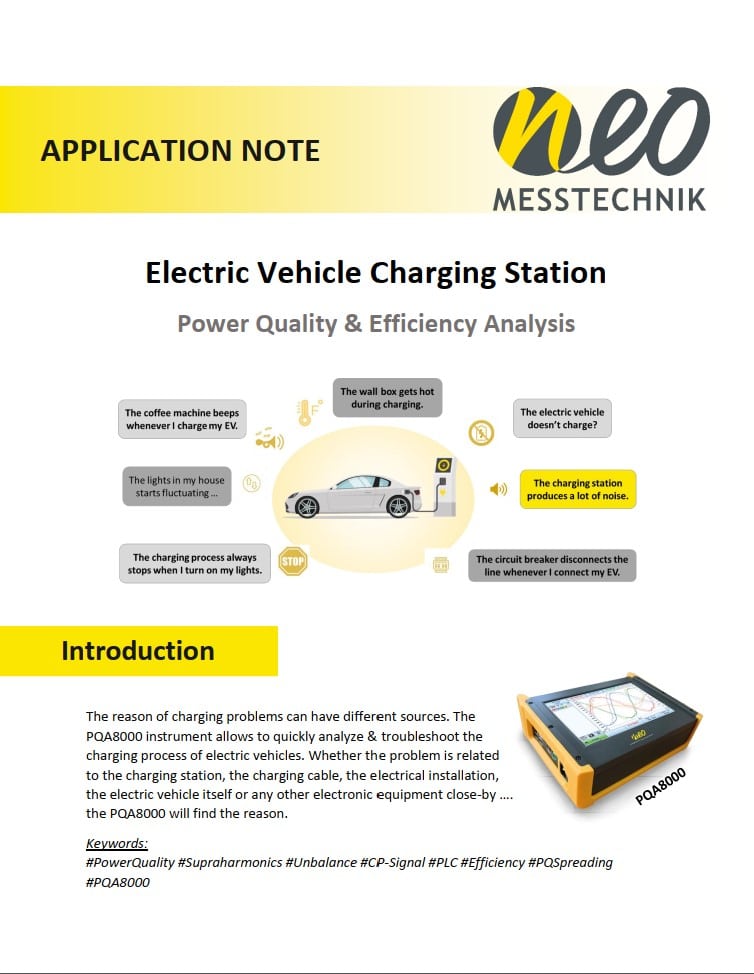
EV Charging – Efficiency Analysis
The reason of EV charging problems can have different sources. The PQA8000 instrument allows to quickly analyse & troubleshoot the charging process of electric vehicles. Whether the problem is related to the charging station,the charging cable ,the electrical installation, the electric vehicle itself or any other electronic equipment close-by…. the PQA8000 will find the reason. Read more.
EN50160, IEC61000-2-2/-4/-12, IEEE 1159, IEEE 519, NRS048
International and national Grid Standards.
FGW-TR3, IEC61400-21, IEC61400-12, BDEW, TOR
International and National Standards for Renewables.
Fundamental frequency
Pure sinus waveform signals only consist of the fundamental frequency, which is well known to be 50Hz, 60Hz or 16 2/3 Hz for electric grids around the world.
Power Quality Explained
Grid Impedance
Measuring the frequency-dependent grid impedance allows drawing conclusions on the propagation and distribution of Supraharmonics (absolute value and angle) and determining how this impedance change is caused by the PE (consumer generator).

AppNote
in our Download Area. Don’t miss out.
IEC 60076-1 / IEC60034
Motor and Transformers Standards
IEC 61000-3-2 /-12 and IEC 61000-3-3 /-11
Equipment Standards
IEC 61000-4-15, IEC61400-21 & Short-time and Long-time Flicker
Flicker is a visible change in lamp brightness due to rapid fluctuations/voltage changes. Learn more about Pst, Plt, IEC 61000-4-15 Flicker meter and Current Flicker and the IEC 61400-21 in our NEO-Blog.
IEEE 1159
Recommended Practice for Monitoring Electric Power Quality
IEEE 519 (Inter-) Harmonics, Full-, half- and sidebands and Higher Frequencies
Harmonics in the grid heavily influence waveforms as well as the operation and life span of electrical equipment. Learn about the guide to Power Quality Measurement and Analysis and it’s implications for the EN 50160 report.
Inverter
Following the previous subchapter about Harmonics, let’s talk about the their cause. Inverters are power electronic devices converting from DC to AC with the specific frequency of the grid. Pulse-width modulation is central to reach this goal and ideally produces minimal harmonic distortion.
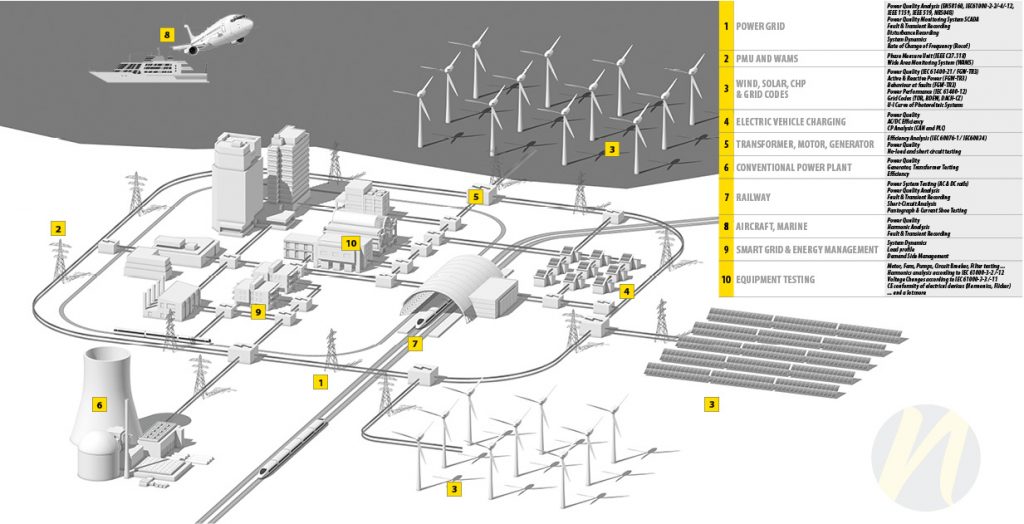
Applications – All over the power grid
Mitigation Analysis
Mitigation of some Power Quality parameters very often increases the penetration of other Power Quality parameters. Typical example is using higher switching frequencies of inverters while reducing lower number harmonics often increases emission at higher frequencies. These types of analyses require synchronous measurements of multiple input channels and instruments.
Negative sequence
As the name already hints, this part of the symmetrical components rotates in the opposite direction as the grid. The phase values are the same with a phase shift of 120° to each other, similar to the positive sequence. Read more.
Phase Angles
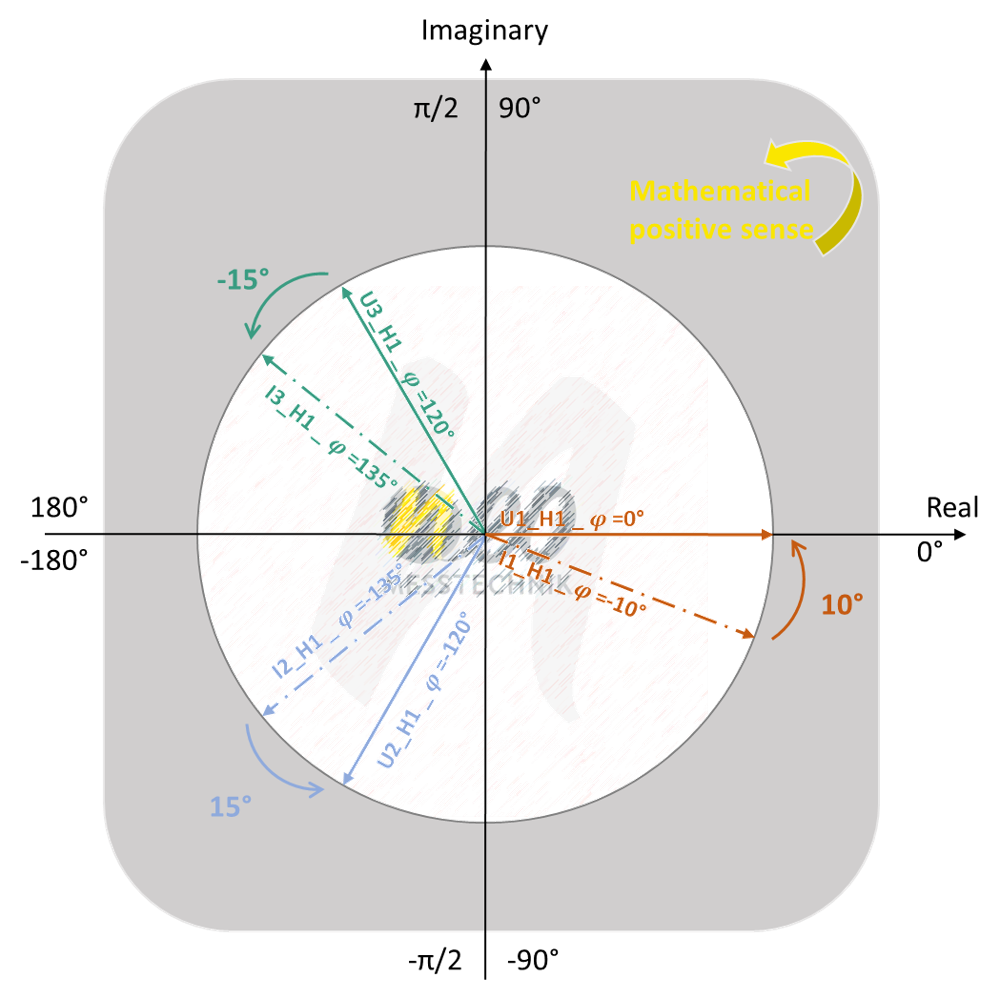
Phase Angle Jumps & System Dynamics
Designing a stable grid that meets the rising share, connection and reconnection of micro-grids or Renewable power plants is where our expertise and instruments come into play. Phase Angle jumps, frequency variations, dips, swells all appear and ask for increasing measurement and analysis efforts.
PLC and Smart Meter
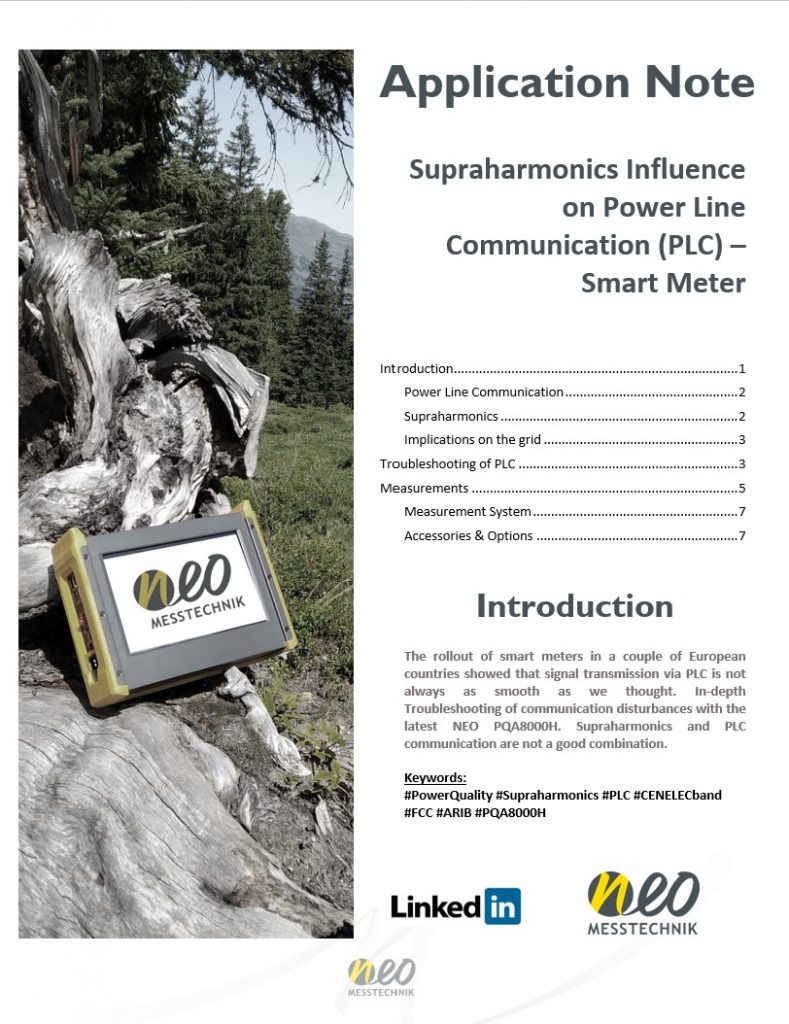
AppNote Available
The rollout of smart meters in a couple of European countries showed that signal transmission via PLC (Power Line Communication) is not always as smooth as we thought. In-depth Troubleshooting of communication disturbances with the NEO PQA8000H show that Supraharmonics and PLC are not a good combination. Read more.
PMU
Phasor Measurement Unit – enables accurate synchrophasor measurements for detecting the status of the electrical grid online. Learn how to achieve a total vector error of 0.01% and angle accurarcy of 0.003° according to IEEE C37.118 here.
Positive sequence
Part of the symmetrical components that rotates in the same direction as the grid, or electric motor, as examples. Is a symmetric system for itself. That said, three positive phase amplitudes with a 120° phase shift to each other. Read more.
Power & Energy
Our daily business and competence for more than 20 years. Read more about central power and energy relations and formulas in Chapter 2.
Power Factor and cos-phi
Must-know knowledge for every electrical/measurement engineer and Power Quality Guide. Click to refresh your memory.
Power Quality Analysis & Monitoring
Recording several electrical and non-electrical inputs and parameters over a short or longer period of time. Goes hand-in-hand with the need of powerful and central instruments that can both handle the high amount of entities as well as storage needs. While in the past several instruments combined enabled Monitoring purposes with missing synchronization options, nowadays integrated instrument solutions like our PQM 200 cover the need within one instrument and solution. Enabling engineers up to 48 channels and the functionalities of Disturbance Recorders, PQ Analyser, Transient Recorder and way more..
PQA 8000H
18bit, 1MS/S, multi-touch display and 4 hours of mobile operation. Read more about How To Spot a Highly Evolved PQ Analyzer. (Disclaimer – this guide about our flagship Power Quality Analyser may cheer you up and lead to giggling in your (home) office).
PQ Explained
Our online success story this Power Quality Guide is a part of! Further build up essential PQ knowledge and get insider tips over several chapters and many more to come!
PQ SCADA
Enterprise management software for Power Quality Analysers and Disturbance Recorder and visualizes live data as well as historic data and reports. Learn more.
RoCoF
Rate of change of frequency. High time derivations of the grid frequency potentially endangers reliability and security of the power supply. Increasing importance due to increasing DER.
Rogowski-Coil
Easy-to-Mount. Ruggedized & Flexible. AC Current induces a voltage as time derivative (di/dt) and passes through an integrator, being proportional to the measured current flow. Ideal for Grid measurements.
Sensor correction
Corrects phase shifts and damped amplitudes due to frequency dependence. Thus enabling high precision measurements from the DC range up to high frequency. Read more.
Supraharmonics

AppNote Available
Power Quality Analysis doesn’t stop at the 50th Harmonic order. Emissions in the frequency range from 9 kHz to 150 kHz are sources of electromagnetic interference to various electric equipment. By design, classic PQ Analysers cannot be used for troubleshooting due to their limited bandwidth. Learn how NEO Messtechnik tackles the challenges of high-frequency disturbances of non-linear loads in today’s power grid here or by reading the AppNote in your Download-Area. Read more.
Switching frequency
In the past, traditionally taught and located in the area of 2-10 kHz. Nowadays experiences major shifts into higher frequency areas, thereby driving various developments of non-linear loads in the grid and stressing PQ instruments with application areas up to 2kHz.
Symmetrical Components
Deviations from the ideal symmetrical power supply result and burden producer and consumers of electrical energy as well as grid components and equipment. The symmetrical components help to make sound statements about the grid status and are major evaluation parameters of Distributed Energy Sources. Learn more about the basics and standards like FGW-TR3, IEC61400-21 and other grid codes renewable power plants need to fulfil to connect to the power grid.
TDD & THD
Total Demand Distortion (TDD) and Total Harmonic Distortion (THD) are both essential IEEE 519 per-Unit values providing information about the share of harmonics.
Transients & Trigger
Detecting any kind of waveform deviations by the help of a multitude of trigger options – the duty of our PQ solutions our customers appreciate. Trigger can be set on input signals (U, I), calculated parameters (P,Q,S, THD, specific Harmonic, etc.) and dynamic signal analysis (1/2 Period values, Phase angle Jumps, RoCoF, Envelope trigger). Furthermore, you can also combine multiple triggers at once.
TSO
A transmission system operator (TSO) is a term defined by the European Commission as an organisation committed to transporting energy in the form of natural gas or electrical power on a national or regional level, using fixed infrastructure. The certification procedure for TSOs is listed in Article 10 of the 2009 Electricity and Gas Directives.
ENTSO-E
Voltage dips and swells
In short, the power supply and it’s voltages are not as steady as you might think.
WAMS
Wide Area Monitoring Systems that visualize and monitor several different parameters which can, optionally, be processed to SCADA or other systems. Aforementioned parameters include phasors, islanding detection, resynchronization and black start detection, oscillations detection, stability and voltage monitoring. Find out more.
Zero-Flux Transducer
Highest Accuracy. AC and DC. Ideal for R&D.
Zero Sequence
Doesn’t exist in a perfect world/grid with symmetry and no losses. As you might guess, a faithful companion and central parameter in real-life measurements.




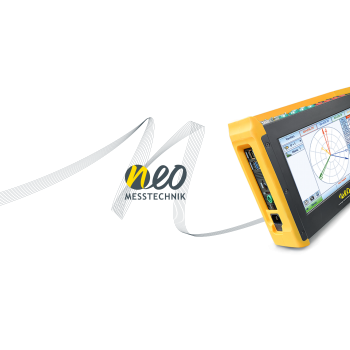

0 Comments